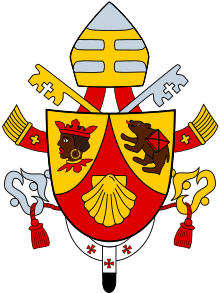Introduction to Christianity
 Book cover | |
| Author | Joseph Ratzinger (Pope Benedict XVI) |
|---|---|
| Original title | Einführung in das Christentum |
| Translator | J. R. Foster |
| Cover artist | Riz Boncan Marsella |
| Country | United States |
| Language | English |
| Subject |
Christology Theology |
| Published | 1968 Ignatius Press |
| Media type | Print, eBook |
| Pages | 300 |
| ISBN | 978-1-58617-029-5 |
| LCCN 2004-103523 | |
| Part of a series on the |
| Theology of Pope Benedict XVI |
|---|
 |
|
|
Introduction to Christianity (German: Einführung in das Christentum) is a 1968 book written by Joseph Ratzinger (Pope Emeritus Benedict XVI). Considered one of his most important and widely read books, it presents a "narrative Christology" that demonstrates the place for faith is in the Church. The book offers a "remarkable elucidation of the Apostle's Creed" and gives an "excellent, modern interpretation of the foundations of Christianity".[1]
Overview
Originally published in German in 1968 under the title, Einführung in das Christentum, Ratzinger restates the Apostles' Creed and the meaning of this foundational text in language that has a greater contemporary resonance than the Creed itself.[N 1] Like the Apostles' Creed, the book presents the doctrines pertaining to the Father, the Son, and the Spirit in sequence.[2]
Contents
- Introduction, "I Believe – Amen"
- I. Belief in the World of Today
- II. The Ecclesiastical Form of Faith
- Part One, God
- I. Prolegomena to the Subject of God
- II. The Biblical Belief in God
- III. The God of Faith and the God of the Philosophers
- IV. Faith in God Today
which provides an argument for God's existence based upon the intelligibility of being qua thought ("thought-being") and for freedom as the "structural form of all being"[3]
- V. Belief in the Triune God
- Part Two, Jesus Christ
- I. "I Believe in Jesus Christ, His Only Son, Our Lord"
- II. The Development of Faith in Christ in the Christological Articles of the Creed
- Part Three, The Spirit and the Church
- I. The Intrinsic Unity of the Last Statements in the Creed
- II. Two Major Questions Posed by the Articles on the Spirit and the Church
Apostle's Creed
I believe in God, the Father almighty, creator of heaven and earth.
And in Jesus Christ, his only Son, our Lord.
Who was conceived by the Holy Spirit and born of the Virgin Mary.
Suffered under Pontius Pilate, was crucified, died, and was buried.
He descended into hell.
On the third day he rose again from the dead.
He ascended into heaven and is seated at the right hand of the Father Almighty.
He will come again to judge the living and the dead.
I believe in the Holy Spirit, the holy catholic Church,
the communion of saints, the forgiveness of sins,
the resurrection of the body, and life everlasting.
Amen.[4]
Editions
The English edition of Introduction to Christianity was revised in 2000 by Ignatius Press with a new preface by Joseph Ratzinger. A second revised edition was released in 2004 by Ignatius Press.
References
- Notes
- ↑ The Apostles' Creed was based on Christian theological understanding of the Canonical gospels, the letters of the New Testament, and to a lesser extent the Old Testament. Its basis appears to be the old Roman Creed. The name of the Creed may come from the fifth-century tradition that, under the inspiration of the Holy Spirit after Pentecost, each of the Twelve Apostles dictated part of it. It is traditionally divided into twelve articles. Saint Ambrose referred to the "Creed of the Apostles" in AD 390.
- Citations
- ↑ "Introduction to Christianity". Ignatius Press. Retrieved February 23, 2012.
- ↑ Burrell, Craig. "Introduction to Christianity". Book Notes. Retrieved February 23, 2012.
- ↑ Joseph Ratzinger, "Introduction to Christianity" (2004: Ignatius Press), pg. 158
- ↑ "Catechism of the Catholic Church". Vatican. Retrieved February 23, 2012.

